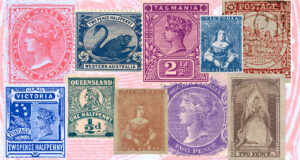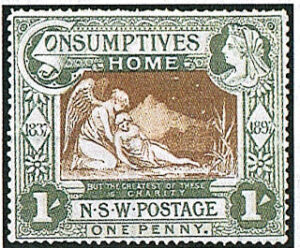 In stamp collecting, there are four “… and States” areas that are collected as cohesive collecting specialties and that have always had tremendous philatelic cachet. They are German States, Italian States, Indian States, and Australian States. Each area is enormously popular and avidly collected as part of classic philately. Each has its own collecting peculiarities, and each can be specialized in by a collector of modest means or expanded into a seven figure international grand award collection. This week’s articles will be focused on each of these four States areas.
In stamp collecting, there are four “… and States” areas that are collected as cohesive collecting specialties and that have always had tremendous philatelic cachet. They are German States, Italian States, Indian States, and Australian States. Each area is enormously popular and avidly collected as part of classic philately. Each has its own collecting peculiarities, and each can be specialized in by a collector of modest means or expanded into a seven figure international grand award collection. This week’s articles will be focused on each of these four States areas.
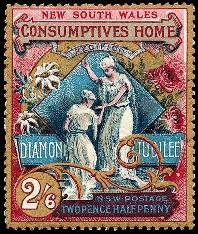 Australia was first seriously settled in the late eighteenth century largely as a penal colony. By the mid nineteenth century, the continent was divided into six main states. Each issued their own postage stamps. The stamps of the Australian States vary widely in rarity and degree of philatelic sophistication needed to collect them. There are great rarities. But most of the thousands of varieties of Australian States stamps can be purchased for considerably under $10 each.
Australia was first seriously settled in the late eighteenth century largely as a penal colony. By the mid nineteenth century, the continent was divided into six main states. Each issued their own postage stamps. The stamps of the Australian States vary widely in rarity and degree of philatelic sophistication needed to collect them. There are great rarities. But most of the thousands of varieties of Australian States stamps can be purchased for considerably under $10 each.
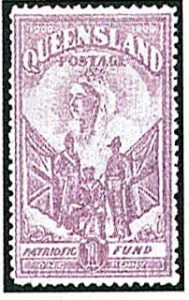 When an American collector, used to the Scott catalog, begins to collect any specialized foreign area, he needs to understand that for most specialized foreign listings, Scott is just picking up the specialized listings that are used in the catalog that native collectors of their area use and giving those listings Scott numbers. Australian States stamps are collected in Australia by the Stanley Gibbons catalog. The Gibbons catalog is the specialized catalog of all of British Commonwealth and has been published continuously for over 150 years by the Gibbons Company in London. All of the major stamp catalogs originally grew out of dealer price lists, but most of the major worldwide catalog publishing companies got out of the stamp selling business years ago (Scott Publishing stopped selling stamps before 1940). This is not true of Stanley Gibbons, who continues to be a major stamp seller as well as a publically traded company that needs to show considerable profits.
When an American collector, used to the Scott catalog, begins to collect any specialized foreign area, he needs to understand that for most specialized foreign listings, Scott is just picking up the specialized listings that are used in the catalog that native collectors of their area use and giving those listings Scott numbers. Australian States stamps are collected in Australia by the Stanley Gibbons catalog. The Gibbons catalog is the specialized catalog of all of British Commonwealth and has been published continuously for over 150 years by the Gibbons Company in London. All of the major stamp catalogs originally grew out of dealer price lists, but most of the major worldwide catalog publishing companies got out of the stamp selling business years ago (Scott Publishing stopped selling stamps before 1940). This is not true of Stanley Gibbons, who continues to be a major stamp seller as well as a publically traded company that needs to show considerable profits.
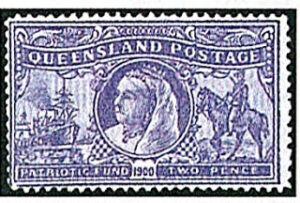 The Stanley Gibbons catalog has a great skew towards shades and cancellation varieties that they tend to list as major numbers. Scott for instance, tends to list a stamp in, say, red as the major number and then list any shades of red as minor varieties. Gibbons can list as many as five or more shades that are very similar as major numbers and these shade differences are often indistinguishable without a very sophisticated reference collection (and maybe even not with one could you tell me the difference between “rosey mauve” and “rose mauve”). And where Scott would list minor perforation varieties as minor numbers, Gibbons again makes
The Stanley Gibbons catalog has a great skew towards shades and cancellation varieties that they tend to list as major numbers. Scott for instance, tends to list a stamp in, say, red as the major number and then list any shades of red as minor varieties. Gibbons can list as many as five or more shades that are very similar as major numbers and these shade differences are often indistinguishable without a very sophisticated reference collection (and maybe even not with one could you tell me the difference between “rosey mauve” and “rose mauve”). And where Scott would list minor perforation varieties as minor numbers, Gibbons again makes 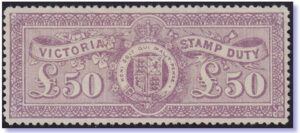 them full fledged varieties.
them full fledged varieties.
Scott has made a valiant effort to prune down the Australian States section of their catalog to more manageable proportions. But collecting Australian States still presents a daunting challenge. But that’s what many collectors want (interestingly, science types tend to predominate in Australian States philately, perhaps because the identification challenges appeals to their precision in thinking). But a collector can still buy a collection of hundreds of different Australian States stamps for a couple hundred dollars and use it as a basis for establishing an intellectually challenging philatelic specialty.
